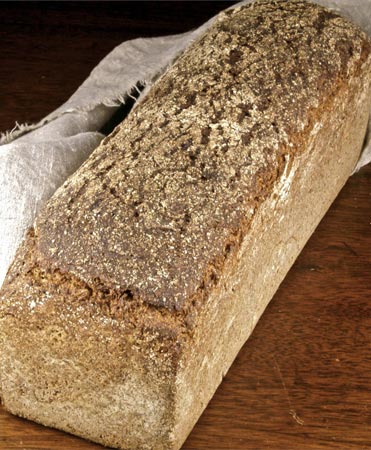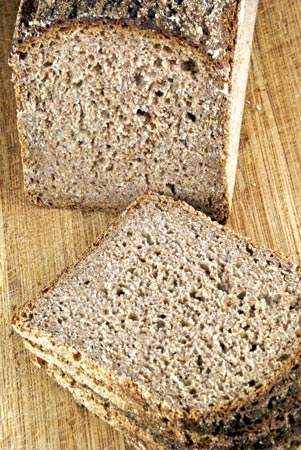
Do you eat rye bread? I didn’t, really, until I started baking and discovered that rye just tastes good. It is earthy and sweet, although sometimes its sweetness is masked by the spices that are often paired with it, such as caraway seeds. To be honest, I prefer my rye unspiced most of the time.
Rye is higher in fiber than wheat, which may explain why a recent study found that eating bread made with a combination of wheat and light rye flours for breakfast made people feel more full and less hungry through the morning than did bread with only wheat flour. Appetite was further decreased by eating bread with even higher proportions of rye bran. That just might translate into some very good news for my waistline, since I’ve been eating this 70% rye bread for breakfast all week.
Consider this bread for all your rye needs. It is based on the “70 Percent Rye with a Rye Soaker and Whole-Wheat Flour” in Bread: A Baker’s Book of Techniques and Recipes by Jeffrey Hamelman. The original recipe calls for rye chops (chopped rye berries), which I don’t have, so I put in all the cracked rye I had (there is supposedly a difference between cracked and chopped rye, but don’t ask me to distinguish them in a lineup) and made up the rest with rye meal (very coarsely ground rye berries).
Rye is more difficult to work with than wheat. This dough has the consistency of thick mud. You just have to deal with it. You will not be able to do a windowpane gluten test on this dough. And when you shape it into a log, for God’s sake don’t think about it or you’ll go crazy. Just turn your brain off and use a quick, light hand and a good amount of flour on the counter. Remember: hands on, brain off.
The recipe instructs you to wrap the bread in linen once cool and wait 24 hours before slicing into it. This will be difficult, because, although this bread contains no sweetener of any kind, the smell of molasses will permeate your kitchen as this bakes and you will just want to get into it right away. However, you will need to control yourself, because if you cut into it too soon, it will be gummy, in which case don’t come crying to me.
This is a huge, heavy, dense loaf that keeps exceptionally well. If you don’t want a megaloaf or don’t have a 13 x 4 x 4 pullman pan, use a regular loaf pan and scale the amount of dough to the volume of the pan. I will leave this as an exercise for the reader. (Are you wishing you’d paid more attention in geometry class now?)
70% Rye with Whole Wheat
Yield: 2000 g (one large loaf)
Time:
- Ferment sourdough and soak soaker: 14 hours
- Mix final dough: 10 minutes
- First fermentation : 30 minutes
- Shape: 5 minutes
- Proof: 1 hour
- Bake: 1 hour 15 minutes
Desired dough temperature: 82F
Rye Soaker Ingredients:
- 172 g cracked rye
- 225 g rye meal
- 424 g boiling water
Rye Sourdough Ingredients:
- 398 g medium rye flour
- 318 g water
- 20 g 100%-hydration rye starter
Final Dough Ingredients:
- 341 g whole wheat flour
- 144 g water
- 5.8 g (scant 2 t.) instant yeast
- 14.3 g (2 1/3 t.) salt
- All of the rye soaker
- All of the rye sourdough
Method:
- For the soaker, combine the cracked rye, rye meal, and boiling water. Cover and let rest for 8 – 14 hours.
- For the rye sourdough, combine the rye flour, water, and rye starter. Cover and ferment at room temperature (70F) for 14 hours.
- In the bowl of a stand mixer with dough hook, combine all of the final dough ingredients. Mix in low speed until everything is incorporated.
- Continue mixing in low speed for about 4 minutes or medium speed for 2 minutes. The dough will be very sticky.
- Transfer the dough to a lightly oiled container. Cover and ferment for 30 minutes.
- Meanwhile, lightly oil a 13 x 4 x 4-inch pullman pan (the lid is not needed) and coat it with whole rye or whole wheat flour.
- Turn the dough into a well-floured counter and roll it into a 12-inch log. Place the log seam-down into the prepared pan and sprinkle it lightly with whole rye or whole wheat flour.
- Cover and ferment at about 82F until the dough has risen just above the top of the pan and the surface is beginning to “break,” about an hour. (Put the pan inside a plastic bag with a bowl of hot water to keep it warm.)
- Meanwhile, preheat the oven, with baking stone, to 480F. You will also need steam during the initial phase of baking, so prepare for this now.
- Bake at 480F for 8 minutes with steam, and another 7 minutes without steam. Reduce the oven to 410F bake for another 45 minutes. Then remove the loaf from the pan and place it on a sheet pan, and bake for another 15 minutes or until the sides are firm and browned.
- Cool on a wire rack. When cool, wrap in linen and wait at least 24 hours before slicing.

A delicious looking loaf! Healthy too!
Cheers,
Rosa
I love rye bread! My current favorite go-to has been the sourdough rye in The Bread Baker’s Apprentice.
I do eat rye bread and I find it really flavourful. Yours looks fantastic.
alright as a nerd i got excited about doing the caalculations about scale.
well, this is definitely a “marathoner-style bread”
🙂
I like the fact you used cracked rye, because that’s what I have, but I am always a bit afraid of changing recipes around. Insecurities…
I’ll have to make this soon…
“Hands on, Brain off” – words to live by! 🙂
I have been wanting to try a rye bread since I bought the Hamelman book. sounds like time to buck up and give it a go.
That looks great! I’ve been waiting for you to post a more traditional rye bread. I think I’ll make this tomorrow—with a few modifications since I’m almost out of cracked rye.
For those of you who didn’t pay attention in geometry class, do this for each of the ingredients:
weight × (length × width × depth) ÷ (13 × 4 × 4)
substituting the weight of the ingredient and the dimensions of your pan.
I finally caved a couple weeks ago and bought a Pullman loaf. And I had to laugh at your description of working with rye!
Great looking loaf. 2 kg of rye bread would probably last me until Halloween. 😉
Beautiful loaf! Like you I prefer my rye without the caraway seeds.
Rye is such a strange beast isn’t it?
I don’t know that I could trust myself to wait 24 hours before cutting into that bread!
I do eat rye bread:) but haven’t had any since I moved to the US 7 yrs ago. Rye bread was popular across the ex-Soviet union countries. My favorite way to enjoy it – spread some ossetra caviar on top and enjoy:) What a luxury these days:)
I don’t really care for rye bread, but by that I mean commercially produced rye bread. I’m sure if we produced our own, I’d love it. Since DPaul is ratcheting up the bread-making, I’ll have to have him try this out.
Looking forward to seeing you at BHFood!
Hi Susan, A beautiful loaf of rye bread! As always, I will be heading down to “the room” to awaken my rye leaven, feed it and bake with it. Your comment about “hands on, brain off” reminds me of my own mantra…
“When you think, you stink!”
-d
Hi – this looks great, have been making your norwich sourdough with a combo of wholewheat, white and rye. Now its time to try a rye loaf I think! Can I leave out the yeast? I am feeling like a bit of a purist…
but where is the molasses?
Hello – the link to the description of the rye meal is unfortunately broken, I am unsure of what rye meal is – is it a type of flour or closer to cracked rye?
Thanks!!